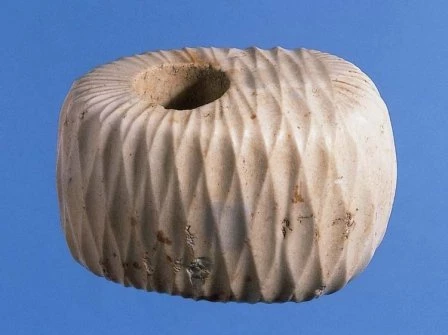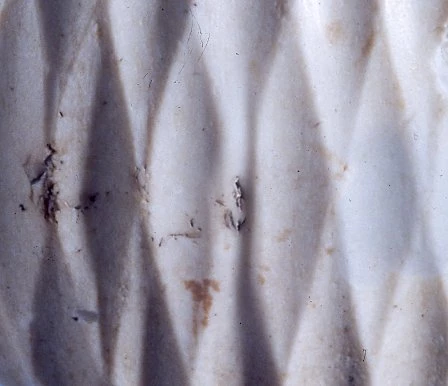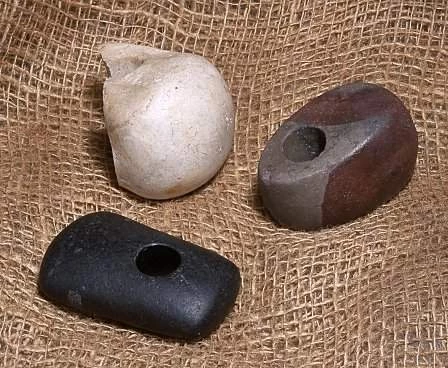A Stone Age masterpiece - A Mace-head from North Wales
The Maesmor mace-head. Discovered in 1840, this artefact was initially thought to be either an Arch Druid's sacrificial hammer, or a war mace belonging to a Celtic chief.
Detail of the carving on the Maesmor mace-head, showing a rare flaw in the design where two chevrons are broken (see centre of image).
Mace-heads from Ogmore (Vale of Glamorgan), Y Fron (Flintshire), and Sker House (Bridgend). The majority of mace-heads made around 2500BC are comparatively simple and undecorated. Examples like these ones have been found throughout Wales.
It is easy to think of the Stone Age as a period in which life was nasty, brutish and short. The Maesmor mace-head from North Wales is proof that it was not always so.
Mace-heads like this one were made around 2500BC, and were typically used for combat. Elaborate mace heads were also created as ceremonial objects and symbols of power within Stone Age tribes.
Many mace-heads have been found in Wales. For the most part they have been discovered by chance, having been disturbed from the spot at which they were lost or discarded. However, occasionally they are found with burials, including one example from Wiltshire, which was found with a body that had been adorned with gold and bone ornaments.
A symbol of power and wealth
This has led to the suggestion that mace-heads were symbols of power and were held by people with status. It is easy to imagine that this would have been true of the Maesmor mace-head since if its owner had only wanted something to use as a club he could have saved himself a lot of trouble by drilling a hole in a pebble and mounting that on the wooden handle.
Instead, a large piece of white flint – a rare stone in Denbighshire where the mace-head was found – was cut roughly into shape. Then a hole was drilled through the tough stone, probably using a bow drill with lots of sand and water. This hole was where the handle would originally have fitted.
Skilled workmanship
But the real skill was the cutting and shaping of the elaborate design on the sides of the mace-head. This was probably also done using the side of a bow drill to score the overlapping grooves.
This process must have taken the maker many tens of hours of work, slowly but gradually shaping first the rough outline, then grinding a hole through the stone before carving out the elaborate decoration on the sides.
The finished mace-head must have been much admired by its owner – possibly the elder of a community, a chieftain, or possibly just a craftsman revelling in his own skill.
Whoever owned the Maesmor mace-head, it demonstrates that even in the Stone Age there was time to make art and time to appreciate it. Luckily, it is still possible to appreciate the decoration that took so much effort and time to create thousands of years later.



Comments - (13)
I have since my last comment completed a flint mace of this type based on the Knowth mace from NewGrange in Ireland, I have yet to conquer a copy of the Maesmor head but it is on my to do list. I would be happy to email you some pictures of my Knowth mace and answer any questions about its production and the hurdles working with flint throws at you when working with it to make these things.
Hi,
Thanks for your comment Skot, you make a fair point, the grind marks do run down the grooves. A few experimental archaeologists have looked at this macehead over the years with the intention of having a go at replicating elements of the design but I'm not aware of anyone who's actually done so. We'd be delighted if you tried and would love to hear how you get on.
Kind regards,
Steve Burrow
(Head of Historic Properties)
I am currently working on some recreations of this technique on stone maces and hope to carve a flint one soon, that way i can experiment and get a clearer picture of how this may have actually been done.
The Maesmawr macehead and the example from Knowth in Ireland date to the late Neolithic (c.3000-2500BC) and are remarkably similar in material, form and decoration.
Maceheads with this ovoid shape and faceted decoration are known as Maesmawr type and the few examples that are known are distributed across Britain from Windmill Hill in Wiltshire, to Sutherland in Scotland. These incredibly fine prestige objects are made from flint which has been shaped and polished before carefully grinding out the lozenge shaped facets.
Most of the known examples of Maewmawr type maceheads are antiquarian finds from uncertain contexts but those maceheads that do have good contexts show that they are rarely found with burials and probably have another type of ceremonial role in Later Neolithic life.
George Eogan and Hilary Richardson, who in 1982 reported on the discovery of the Knowth macehead in the Journal of the Royal Society of Antiquaries of Ireland, believed the relief decoration of spirals and curved demonstrated that it was not an import from Britain but an Irish take on the Maesmawr form.
Hi there Adam, thanks for your comment. It really is such a beautiful object, and it would be interesting to know whether there is a connection with the Knowth mace head.
I'll pass on your comment to our curators and post their reply when I get it.
Thanks again for your enquiry
Sara
Digital Team